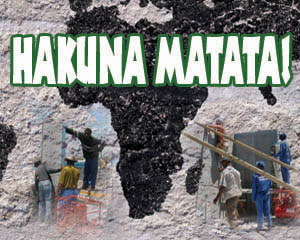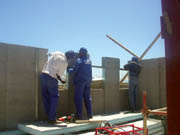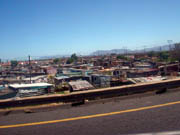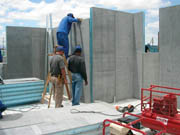

Given these realities, one Hamilton, Ohio-based manufacturer took a trek to Africa to enjoy a warmer climate and a cultural construction odyssey.
On January 25, 2004, the T. Clear Corp. went to Cape Town, South Africa, to install its building system, the ProTEC concrete structural insulated panel, to the people living in Mitchell's Plain. The project was a collaboration between the company, the Ohio Southern Africa Trade Office and Applied Innovation Inc., of Columbus, Ohio.
Ted Clear, president of T. Clear and Jeff Ketterer, product manager for ProTEC, made the 18-hour flight to Cape Town to assist in the construction phase of the project.
"I made the promise to the people of South Africa that we would come to Cape Town and have the ProTEC walls up and set roof trusses during our five day visit," Clear says. "I was told that this would be impossible because of the complexity of the project."
The facility that was constructed was an Assisted Living Complex for Ohio/Catholic Welfare and Development. The facility constructed was a six-bedroom, two-bathroom structure complete with a lounge, living room, dining room, kitchen and laundry room. More than 125 panels were used on the exterior and interior walls and required three different lengths of panels.

Out of Africa
T. Clear worked in South Africa with Stocks Building Africa. Stocks Building is a major construction company in the Western Cape and was interested in introducing the technology in the area. Jacques Du Toit, managing director for Stocks, coordinated the construction of the project."We have been working closely with Jacques since our visit in an effort to bring our product to an affordable housing project with Stocks," says Ketterer. "We are currently working on house plans ranging in the 30 to 35 square meter range. The plans are being modified slightly to work most efficiently with our panelized system."
One of the most interesting twists to the project according to Clear and Ketterer was the crew that they had the opportunity to work with.
"We actually worked with some of the men from the Mitchell's Plain development," according to Clear. "The men had little or no construction background and had never seen this panel system. On top of this, they spoke little or no English and we didn't speak any Africanse. However, the men learned how to set and cut panels in a very short time frame and communicate with one another. Jeff actually ran the crew and showed them how to set panels and use our nail-gun."
"The men were afraid of the nail-gun when I first showed them how to operate it," Ketterer adds. "They had never been exposed to this kind of technology."

SIPping safari
Traditional building practices in this area are out of concrete bricks and block. It is a very time consuming effort to construct homes. According to Jacque Du Toit, the African government has set monies aside for affordable, decent housing for the people of Africa. The main issue is the time involved to build the amount of housing that is needed. This is where this panel system has a great advantage over traditional practices."We feel that we can set panels on four to five houses a day in the range being looked at," says Ketterer. "This would simply blow away anything that I saw during our week stay in the area."
In addition to the speed of construction, the panel system also offers mold and moisture resistance and R-20 insulation value. The company provided framing, insulation and sheathing all in a ready-to-finish panel, inside and out. Each panel consists of a core of Dow Chemical Styrofoam insulation, bonded, front and back, to sheets of Util-A-Crete Concrete Backer Board, also manufactured by Fin Pan Inc./T. Clear Corp. The panels are slotted and connected by means of galvanized steel channels and nail-in fasteners.
All said, it was a life changing experience for both men.
"I thought I had seen poverty in the United States but nothing compares to what I personally witnessed in South Africa," Ketterer adds.
"Whether we sell another panel in the country or not, we had the pleasure of knowing that we made a difference in the peoples lives in South Africa," Clear says.

Report Abusive Comment